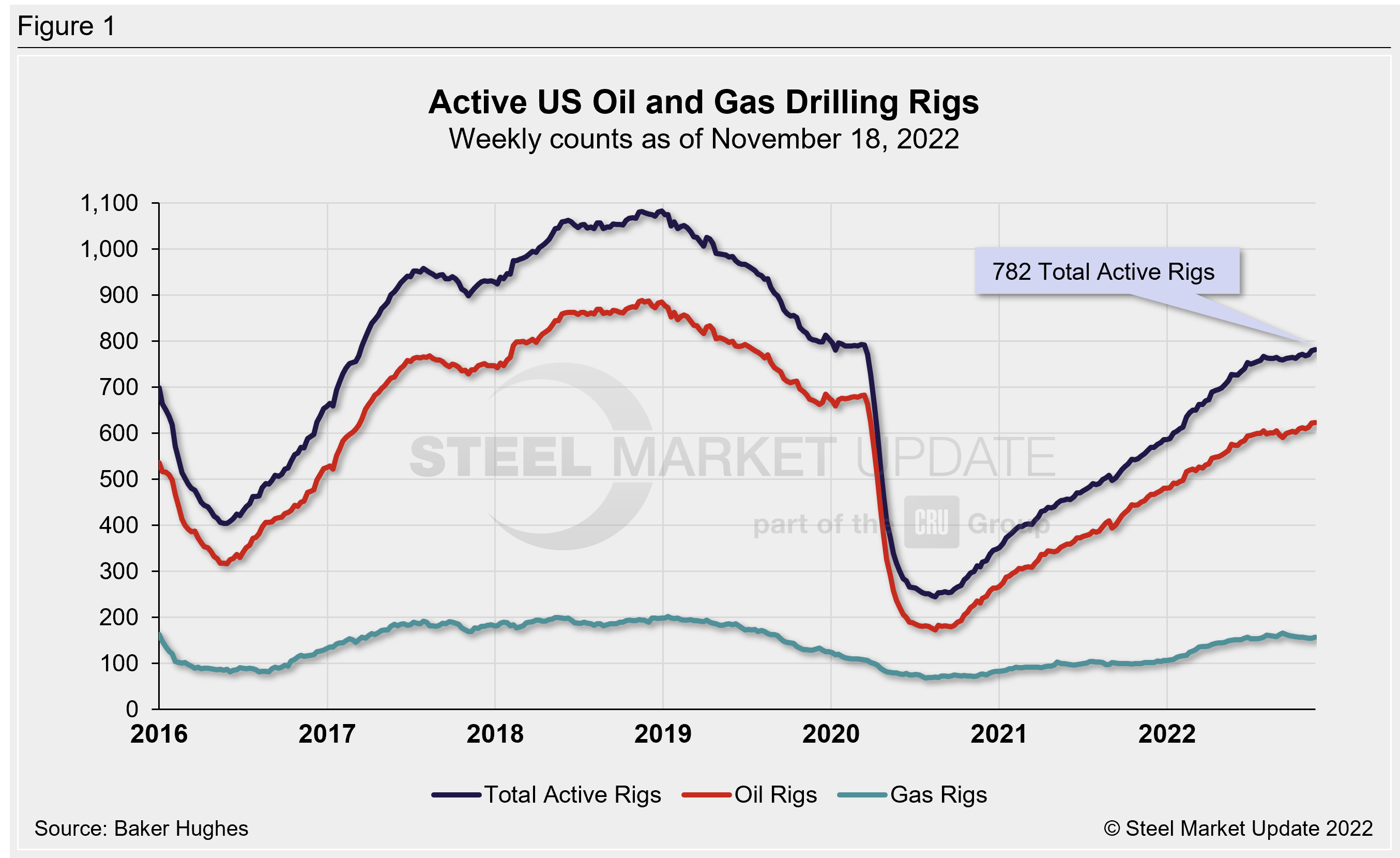Environment and Energy

Active Drill Rigs: US, Canadian Counts Up Modestly
Written by Brett Linton
November 20, 2022
The number of active drilling rigs increased this week in both the US and Canada, according to data from oilfield services company Baker Hughes.
Counts have been trending in different directions in recent weeks. Drilling activity in the US continues to improve, although it is still not back to pre-Covid levels. Canadian rig counts have been roughly flat or declining since October but are in the ballpark with levels seen prior to 2020.
The number of oil and gas rigs in operation is important to the steel industry because it is a leading indicator of demand for oil country tubular goods (OCTG), a key end market for steel sheet.
The number of active US rigs increased by three to 782 rigs, with oil rigs up one, gas rigs up two, and miscellaneous rigs unchanged from last week. Compared to this time last year, this week’s US count is up 219 rigs, with oil rigs up 162, gas rigs up 55, and miscellaneous rigs up two. See Figure 1 for a history of active US rig counts.
The Canadian rig count rose by one this week to 201 rigs, with oil rigs up two, gas rigs down one, and miscellaneous rigs unchanged. This week’s count is up 34 rigs compared to levels one year ago, with oil rigs up 33, gas rigs up one, and miscellaneous rigs unchanged. See Figure 2 for a history of active Canadian rig counts.
International rigs increased by 32 to 911 rigs for the month of October and are up 111 rigs from the same month one year ago.
For more in-depth information on the energy market, Steel Market Update publishes an “Energy Update” report each month covering oil and natural gas prices, detailed rig count data, and oil stock levels. Our October report is available here for Premium members.
For a history of both the US and Canadian rig count, visit the Rig Count page on the Steel Market Update website here.
About the Rotary Rig Count
A rotary rig is one that rotates the drill pipe from the surface to either drill a new well or to side track an existing one. Wells are drilled to explore for, develop and produce oil or natural gas. The Baker Hughes Rotary Rig count includes only those rigs that are significant consumers of oilfield services and supplies.
The Baker Hughes North American Rotary Rig Count is a weekly census of the number of drilling rigs actively exploring for or developing oil or natural gas in the US and Canada. Rigs considered active must be on location and drilling. They are considered active from the time they break ground until the time they reach their target depth.
The Baker Hughes International Rotary Rig Count is a monthly census of active drilling rigs exploring for or developing oil or natural gas outside of the US and Canada. International rigs considered active must be drilling for at least 15 days of the month. The Baker Hughes International Rotary Rig Count does not include rigs drilling in Russia or onshore in China.
By Brett Linton, Brett@SteelMarketUpdate.com

Brett Linton
Read more from Brett LintonLatest in Environment and Energy

AISI announces publication of environmental rules for N. American steel construction products
The American Iron and Steel Institute (AISI) has announced the publication of the third version of the Product Category Rules (PCR) for North American Steel Construction Products.

Reports: Federal funding for Cliffs’ project could be slashed
Elon Musk's DOGE is determining which Department of Energy grants to advance and which ones to terminate, according to several media outlets

Flack’s Fabral launches solar division
The metal roofing manufacturer is launching Fabral Solar to integrate solar technology within commercial, residential, and agricultural structures.

Trump intends to declare ‘national energy emergency,’ focus on fossil fuels
The incoming administration said it also wants to streamline permitting and roll back regulations.

Nucor carbon targets certified by GSCC
Nucor’s “ambitious” carbon targets by the end of the decade and beyond have been certified by the Global Steel Climate Council (GSCC). The Charlotte, N.C.-based steelmaker used a base year of 2023 for its science-based emissions targets (SBET). It set an SBET of 0.975 metric tons (mt) of CO2 emissions per mt of hot-rolled steel […]



